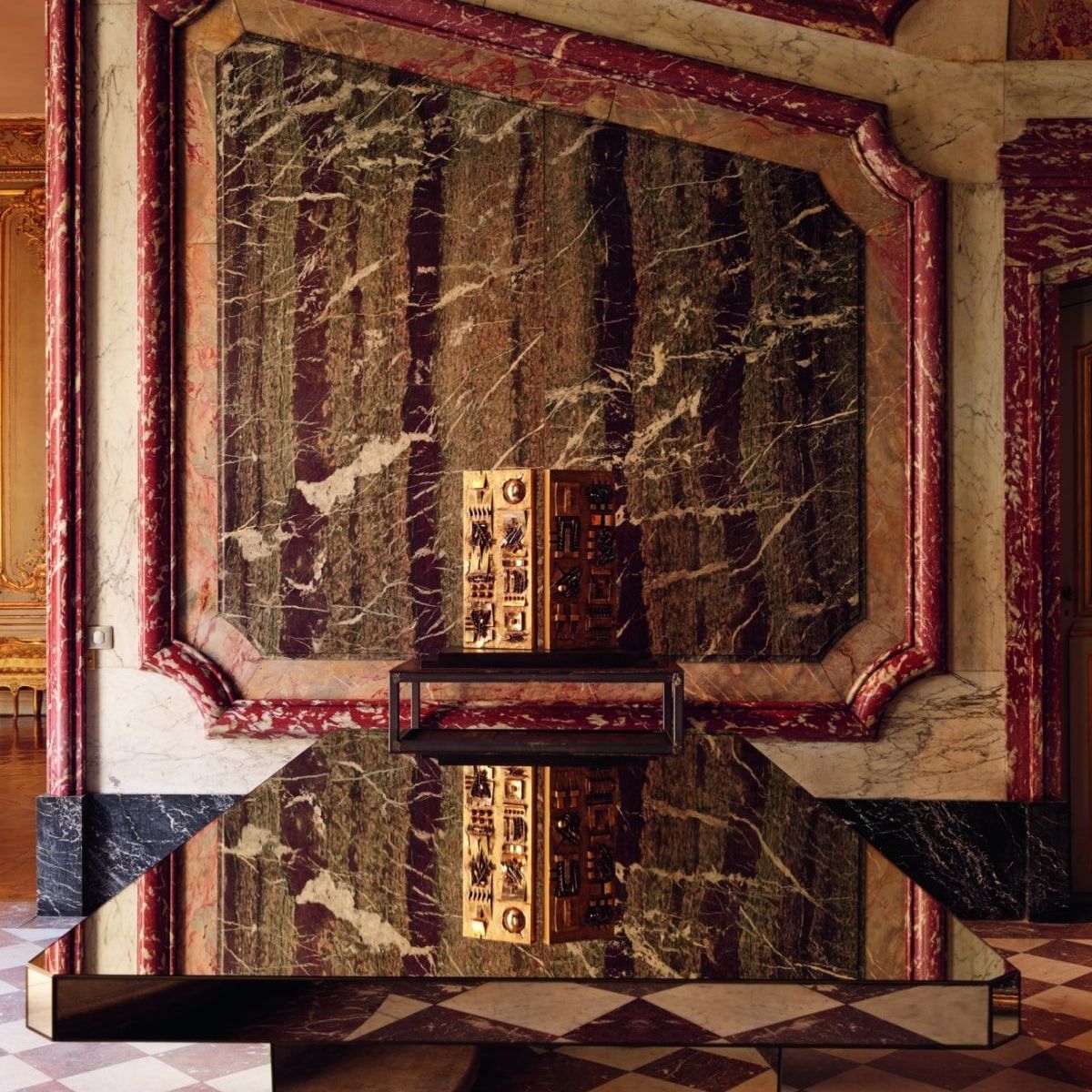
Standway, Ines and Cicladi. Furnishing the precious Salon of Allegories are the three sofas covered in Minerals Collection Pure Gold in chaise longue versions with Pepita feet, alabaster tables and gilded lamp.
October 2024
The Italian Embassy in Paris
Gold, tapestries, mirrors, marble. In the rooms, halls and grand stairway of the eighteenth-century Hôtel de La Rochefoucauld-Doudeauville in Paris, home to the Italian Embassy in France since 1937, we can breathe the splendour and glory of history.
In these prestigious, memory-filled spaces, on 16 May 2024, during one of the specially designated Italian Design Days, Edra presented its collection in the presence of Ambassador Emanuela D'Alessandro, confirming its commitment to acting as spokesperson for the values of timeless beauty and elegance at the foundation of Italian culture. With Edra, contemporary design's excellence and quality entered a place that is timeless, a place embodying the noblest part of Parisian architectural tradition, a juxtaposition of antique and contemporary that produced a deeply evocative effect.
“Although these elements have been placed in the setting of an 18th century Hôtel" said Ambassador D'Alessandro, "it feels they have been here forever. Indeed wherever visitors turned their gaze they could only wonder at the naturalness of the Edra collection residing harmoniously in the Hôtel”.
The Tatlin sofa by Roberto Semprini and Mario Cananzi, its spiral structure covered in gold leather, took up residence in the large Globe Salon, positioned on a carpet designed by Daniel Roseberry, creative director at Maison Schiaparelli. The carpet, a deep shade of blue, with brushstrokes of white and gold, one of which also forms a spiral, connected with the sofa through analogies of form, the two elements echoing, rhyming and citing each other in a series of mutual homages.
In the Four Continents Salon, under a large centrally positioned chandelier, a trio of Diamante tables glittered.
Each room was a new marvel.
In the Chinese Salon, the Scrigno sideboard by the Campana brothers stood shining brightly against panelling in shades of cream and yellow.
Cicladi tables and gold Ines lamps were parts that perfectly related and integrated with the overall atmosphere of hushed refinement in the Salon of Allegories, a transparent niche embellishing walls of gilded panelling to create an optical illusion of false mirroring.
Outside, on a terrace overlooking the garden, Jacopo Foggini's A'Mare collection, flooded with sunlight, shimmering like a living being, offered its illusion of solid water to the senses.
This harmonious integration of contemporary works into a historical context is a choice, part of a wider project that aims to vivify the Italian Embassy's Paris headquarters, giving it new energy and creating layers of values and memory, of art and beauty.
In a building whose functions are institutional and representative it is an extraordinary challenge to value history and memory while also generating fusions and crossovers to spark relations with the present.
Behind these choices there is a precise cultural operation. This is not simply a question of furnishing some of the Hôtel's rooms, but of reaffirming the strength of an Italian culture more alive than ever, of conveying to the world the continuity of fertile ties between high technology, the manufacturing industry and quality artisan craftsmanship.
Made in Italy has always been known for its distinctive character, timeless elegance and attention to detail. Italian design is globally perceived as a symbol of excellence and authenticity, capable not only of conveying beauty but also tradition, innovation, quality and sustainability.
Edra works with its own profoundly cultural project: by sharing beauty in different forms of art it seeks to make known the exceptionally high quality of its collections, the complex and articulated values of its overarching project, while at the same time providing an experience that involves the emotions, senses and rational thought, in a journey embracing diverse places and contexts.
To conclude, in the Teatro Siciliano transferred from Palermo to the Paris Hôtel in the early 1900s, Edra announced to an audience of journalists and institutional representatives that certain pieces of its collection will now continue to inhabit the Embassy, and that once again, for the Paris 2024 Olympics, Edra will be involved in the Casa Italia project.
The whole was accompanied by the presentation of Edra Amendola, the new book published by Treccani in which eminent photographer Aurelio Amendola, friend to some of the 20th century's most renowned artists, from Burri to Marino Marini, from Warhol to De Chirico, renders homage to the Edra collection, in a series of luminously beautiful black and white photographs, with the same sensitivity he has demonstrated in photographing the sculptures of Canova, Bernini and Michelangelo,
A vocation of the Embassy, in this extraordinary setting of the Hôtel de La Rochefoucauld-Doudeauville, is to be a hub for an international community. It is important to convey to the world through projects like this that Italy is not living on vestiges of the past, but continues to be a generative driving force of culture and excellent production.
Embassies are not simply places of diplomatic representation but centres of real cultural promotion and international dialogue. Through initiatives like this, the embassy's role as a bridge between nations is strengthened, as it advocates for a dynamic and innovative image of Italy, encouraging cultural and artistic cooperation on a global level.
 |
Silvana Annicchiarico Architecte, vit à Milan et travaille comme chercheur, critique et enseignant. Elle est consultante auprès d'organismes publics et d'entreprises privées. Dans les expositions et publications auxquelles elle participe, elle aborde les problématiques contemporaines, les œuvres des grands maîtres et les nouveaux noms du design. De 2007 à 2018, elle a été directrice du Triennale Design Museum de la Triennale de Milan. |

















